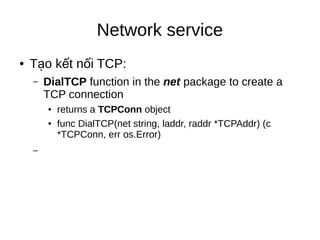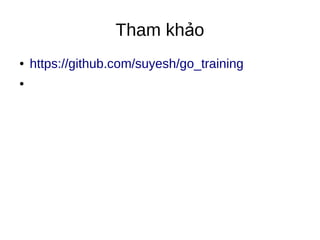Golang web database3
- 2. Database â Go doesn't provide any database drivers, but it does have a driver interface defined in the database/sql package â The advantage is that if your code is developed according to these interface standards, you will not need to change any code if your database changes. â We always see the following code when we use third-party drivers: â Import ( "database/sql" _ "github.com/mattn/go-sqlite3" ) â Here the underscore (also known as a 'blank') â_â: â â_â ÄÆ°áŧĢc dÃđng trong cÃĄc hà m (func) lÚc trášĢ váŧ cÃĄc giÃĄ tráŧ mà chÚng ta khÃīng cᚧn thÃŽ chÚng ta sáš― loᚥi báŧ nÃģ (discarding) Khi bᚥn import máŧt thÆ° viáŧn thÃŽ bᚥn sáš― phášĢi dÃđng tášĨt cášĢ cÃĄc package ÄÃģ (nášŋu khÃīng dÃđng package ÄÃģ trong Äoᚥn code nà o ÄÃģ thÃŽ Go sáš― biÊn dáŧch và cášĢnh bÃĄo lᚥi). â khi sáŧ dáŧĨng underscore â_â khi import thÆ° viáŧn thÃŽ cÃģ nghÄĐa là bᚥn cháŧ cᚧn dÃđng function init() mà khÃīng cᚧn sáŧ dáŧĨng tráŧąc tiášŋp â tÃnh nÄng nà y cᚧn thiášŋt cho registering database drivers vÃŽ nÃģ sáš― táŧą Äáŧng ÄÄng kÃ― database drivers mà khÃīng cᚧn phášĢi gáŧi nÃģ
- 3. Database â Function: â sql.Register(): registering database drivers when you use third-party database drivers. â Gáŧi hà m nà y trong hà m init() â driver.Driver: is an interface containing an Open(name string) method that returns a Conn interface. â driver.Conn: This is a database connection interface with some methods the same Conn can only be used in one goroutine. â driver.Stmt â driver.Tx
- 4. Database â Quy trÃŽnh: â Step 0: Importing a Database Driver â L y package:ášĨ â go get github.com/go-sql-driver/mysql â Import trong mÃĢ ngu náŧ import ( "database/sql" _ "github.com/go-sql-driver/mysql" )
- 5. Database â Quy trÃŽnh: â Step 1: s d ngáŧ áŧĨ sql.Open Ä chu n b k t n iáŧ ášĐ áŧ ášŋ áŧ â db, err := sql.Open(<driver name>, <command_to_connect>) â <command_to_connect>: driver-specific syntax that tells the driver how to access the underlying datastore â GiÃĄ tr tr v : c n ki m traáŧ ášĢ áŧ ᚧ áŧ handle errors â Và d :áŧĨ â db, err := sql.Open("mysql", "user:password@tcp(127.0.0.1:3306)/hello") â db, err := sql.Open("mysql", "<user>:<password>@/test?charset=utf8") â Sql.Open ch a t o k t n i ngayÆ° ᚥ ášŋ áŧ â NÃģ t o k t n i ch khi nà o cÃģ yÊu c u (query) Ä u tiÊn.ᚥ ášŋ áŧ áŧ ᚧ ᚧ â db.Ping() dÃđng Ä ki m tra database is available and accessible (foráŧ áŧ example, check that you can establish a network connection and log in)
- 6. Database â Quy trÃŽnh: â Step 2: T o m i d li u, g m 3 b c:ᚥ áŧ áŧŊ áŧ áŧ Æ°áŧ â stmt, err := db.Prepare(<command>): chu n b Ä nh d ng d li u Ä chÃĻn và o DBášĐ áŧ áŧ ᚥ áŧŊ áŧ áŧ â returns a SQL operation that is going to be executed. It also returns the execution status after executing SQL. â db là giÃĄ tr tr v t hà m slq.Open()áŧ ášĢ áŧ áŧŦ â Và d : db.Prepare("INSERT userinfo SETáŧĨ username=?,departname=?,created=?") â res, err := stmt.Exec(<data>): th c hi n l nháŧą áŧ áŧ â Stmt là giÃĄ tr tr v t hà m db.Prepare()áŧ ášĢ áŧ áŧŦ â <data>: là m u chu n theo th t ÄÃĢ xÃĄc Ä nh trÊn b c chu n b trÊnášŦ ášĐ áŧĐ áŧą áŧ Æ°áŧ ášĐ áŧ â Và d : stmt.Exec("astaxie", "a72", "2016-12-09") â tuÃĒn theo chu n <username,departname,created> trÊnáŧĨ ášĐ áŧ â res.<Action>: Ä c giÃĄ tr tr v sau khi th c hi n l nháŧ áŧ ášĢ áŧ áŧą áŧ áŧ â res là giÃĄ tr tr v t hà máŧ ášĢ áŧ áŧŦ stmt.Exec() â CÃģ cÃĄc Action khÃĄc nhau: â id, err := res.LastInsertId() â affect, err := res.RowsAffected()
- 7. Database â Quy trÃŽnh: â Step 3: Truy v n tÃŽm ki m d li uášĨ ášŋ áŧŊ áŧ â L nh truy v n:áŧ ášĨ db.Query(<command_to_query>) â rows, err := db.Query("SELECT * FROM userinfo") â Duy t danh sÃĄch tr v :áŧ ášĢ áŧ â rows.Next(): â rows.Scan(): read the columns in each row into variables â defer rows.Close(): ÄÃģng rows for rows.Next() { â l y l n l t cÃĄc row tr vášĨ ᚧ Æ°áŧĢ ášĢ áŧ err = rows.Scan(&uid, &username, &department, &created) }
- 8. Database â Quy trÃŽnh: â Step 4: XÃģa d li u (t ng t nh Step2)áŧŊ áŧ Æ°ÆĄ áŧą Æ° â stmt, err = db.Prepare(<command_to_del>) â <command_to_del>: là l nh mysql Ä xÃģa d li uáŧ áŧ áŧŊ áŧ â stmt, err = db.Prepare("delete from userinfo where uid=?") â res, err = stmt.Exec(id) â Stmt thi u giÃĄ tr d li uášŋ áŧ áŧŊ áŧ id nÊn l nh nà y Ä a id và o và th c thiáŧ Æ° áŧą l nh xÃģaáŧ â affect, err = res.RowsAffected() Note that we use the format =? to pass arguments. This is necessary for preventing SQL injection attacks.
- 9. Database â Và d Ä c DB Mysql:áŧĨ áŧ â K t n i:ášŋ áŧ â db, err := sql.Open("mysql", "astaxie:astaxie@/test?charset=utf8") â db.Close() â Ghi d li u:áŧŊ áŧ â stmt, err := db.Prepare("INSERT userinfo SET username=?,departname=?,created=?") â res, err := stmt.Exec("jace", "jace in corp", "2015-12-09") â id, err := res.LastInsertId() â ki m ch ng l n ghi d li u v a r iáŧ áŧРᚧ áŧŊ áŧ áŧŦ áŧ â C p nh p/S a d li uáš áš áŧ áŧŊ áŧ â stmt, err = db.Prepare("update userinfo set username=? where uid=?") â res, err = stmt.Exec("astaxieupdate", id) â affect, err := res.RowsAffected() â ki m ch ng l nh update cÃģ ÄÚng Ä i t ng (rows)áŧ áŧĐ áŧ áŧ Æ°áŧĢ â TÃŽm ki m d li u:ášŋ áŧŊ áŧ â rows, err := db.Query("SELECT * FROM userinfo") â for rows.Next() {err = rows.Scan(&uid, &username, &department, &created)} â XÃģa d li u:áŧŊ áŧ â stmt, err = db.Prepare("delete from userinfo where uid=?") â res, err = stmt.Exec(id) â th c thi l nh xÃģaáŧą áŧ â affect, err = res.RowsAffected() â ki m ch ng l nh xÃģa cÃģ ÄÚng Ä i t ng khÃīngáŧ áŧĐ áŧ áŧ Æ°áŧĢ
- 10. Database â Là m vi c v i Redisáŧ áŧ â redis is a key-value storage system like Memcached, that supports the string, list, set and zset(ordered set) value types. â Download: http://redis.io/download â Cà i Ä t và th nghi m:áš· áŧ áŧ â Ch y server: src/redis-serverᚥ â T ng tÃĄc, thao tÃĄc d li u v i server: src/redis-cliÆ°ÆĄ áŧŊ áŧ áŧ â set foo bar â get foo â L y th vi n database driver:ášĨ Æ° áŧ â go get github.com/astaxie/goredis
- 11. Database â Là m vi c v i Redisáŧ áŧ â CÃĄc th vi n giao ti p v i redis:Æ° áŧ ášŋ áŧ â https://github.com/fzzy/radix â https://github.com/alphazero/Go-Redis â Current status is compatible with Redis 2.4.n (2.4.9 tested) and Go 1 â ÄÃĢ lÃĒu khÃīng cÃģ b n c p nh tášĢ áš áš â https://github.com/simonz05/godis â b n c p nh t ÄÃĢ khÃĄ cÅĐ (2012)ášĢ áš áš â https://github.com/hoisie/redis â Designed for Redis 2.6.x. â https://github.com/garyburd/redigo â B n m i nh t và o ThÃĄng 5/2016ášĢ áŧ ášĨ â
- 12. Database â Là m vi c v i Redis:áŧ áŧ â M t s và d t ng tÃĄc v i Redis:áŧ áŧ áŧĨ Æ°ÆĄ áŧ â https://github.com/ovr/go-redis â https://github.com/wen866595/gredis â https://github.com/hongruiqi/redis.go â
- 13. cookies â Cookies g m cÃĄc tr ng:áŧ Æ°áŧ â Name: string â Value: string â Path: string â Domain: string â Expires: time.Time â RawExpires: string â MaxAge: int â Secure: bool â HttpOnly: bool â Raw: string â Unparsed: []string â Go uses the SetCookie function in the net/http package to set cookies: â http.SetCookie(w ResponseWriter, cookie *Cookie) â Hà m nà y cÃģ th dÃđng cho c 2 tr ng h p t o cookies và xÃģa cookies.áŧ ášĢ Æ°áŧ áŧĢ ᚥ
- 14. cookies func login(w http.ResponseWriter, r *http.Request) { SetCookie(w) } login là 1 Handler c a web.áŧ§ Hà m Setcookie s d ng ReponseWriter Ä tr v cho clientáŧ áŧĨ áŧ ášĢ áŧ func sayhelloName(w http.ResponseWriter, r *http.Request) { GetCookie(r) } sayhelloName là 1 Handler c a webáŧ§ Hà m Getcookie s d ng Request do nh n cÃĄc thÃīng s t clientáŧ áŧĨ áš áŧ áŧŦ
- 15. cookies func SetCookie(res http.ResponseWriter) { expiration := time.Now().Add(365 * 24 * time.Hour) cookie := http.Cookie{ Name: "my-cookie", Value: "COOKIE MONSTER", Expires: expiration} http.SetCookie(res, &cookie) } func GetCookie(req *http.Request) { cookie, err := req.Cookie("my-cookie") if err == nil { fmt.Println("has cookie") fmt.Println("get cookie") fmt.Println(cookie) fmt.Println(cookie.Value) fmt.Println(cookie.Expires) } else{ fmt.Println("please set cookie") fmt.Println(err) } } func ClearCookie(res http.ResponseWriter) { cookie := http.Cookie{ Name: "my-cookie", Value: "COOKIE MONSTER", MaxAge: -1} http.SetCookie(res, &cookie) }
- 16. Session â https://github.com/MorpheusXAUT/eveauth â CÃģ cÃĄc th vi n c n thi t v thao tÃĄc sessionÆ° áŧ ᚧ ášŋ áŧ â https://github.com/icza/session â Th vi n v i cÃĄc ch ng nÄng qu n lÃ― session khÃĄÆ° áŧ áŧ áŧĐ ášĢ h u d ngáŧŊ áŧĨ
- 17. Network service â we need an IP address and port number to have a unique socket. â TCP socket â TCPConn struct Ä mÃī t 1 k t n i socket.áŧ ášĢ ášŋ áŧ â TCPConn can be used by either client or server for reading and writing data. â after a connection is established, the server has the same type of connection object for the current connection â c phÃa client và server cÃđng cÃģ 1 object Ä mÃī t k t n i.ášĢ áŧ ášĢ ášŋ áŧ â clients send requests to servers through a TCPConn and receive information from the server response â servers read and parse client requests, then return feedback â two key functions: â func (c *TCPConn) Write(b []byte) (n int, err os.Error) â func (c *TCPConn) Read(b []byte) (n int, err os.Error) â TCPAddr struct to represent TCP address information: â ResolveTCPAddr function to get a TCPAddr
- 18. Network service â T o k t n i TCP:ᚥ ášŋ áŧ â DialTCP function in the net package to create a TCP connection â returns a TCPConn object â func DialTCP(net string, laddr, raddr *TCPAddr) (c *TCPConn, err os.Error) â
- 19. Tham kh oášĢ â https://github.com/suyesh/go_training â
Editor's Notes
- #5: import ( &quot;database/sql&quot; _ &quot;github.com/go-sql-driver/mysql&quot; )
- #7: import ( &quot;database/sql&quot; _ &quot;github.com/go-sql-driver/mysql&quot; )
- #8: import ( &quot;database/sql&quot; _ &quot;github.com/go-sql-driver/mysql&quot; )
- #9: import ( &quot;database/sql&quot; _ &quot;github.com/go-sql-driver/mysql&quot; )
- #15: Máŧi 1 webserver cháŧ cÃģ 1 loᚥi handler nÊn cÃĄc hà m lášĨy và tᚥo cookie thÆ°áŧng ÄÆ°a và o Package hoáš·c Func Äáŧ gáŧi táŧŦ bÊn trong cÃĄc Handler, pháŧĨc váŧĨ viáŧc kiáŧm tra Äiáŧu kiáŧn cho cÃĄc Handler

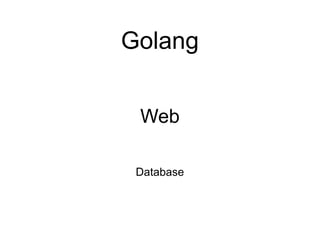
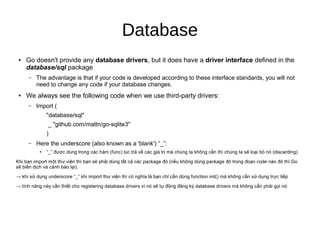
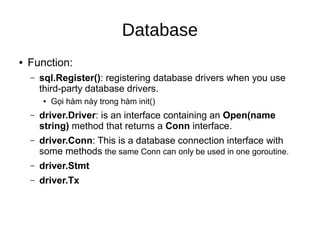
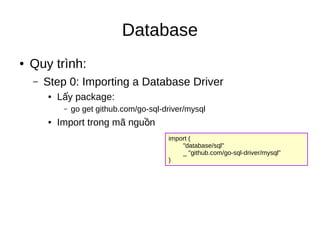
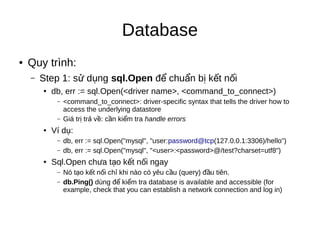
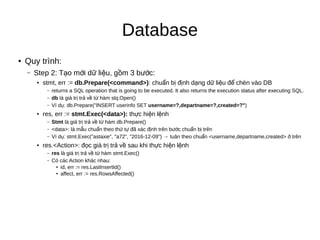

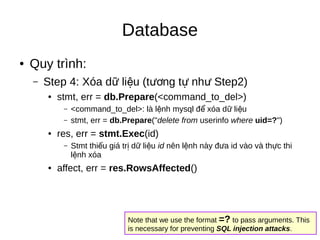
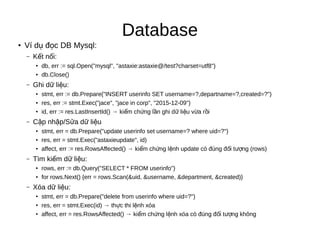
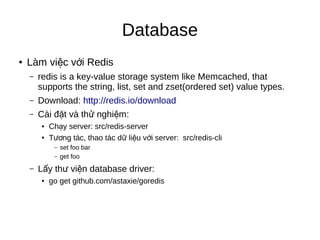
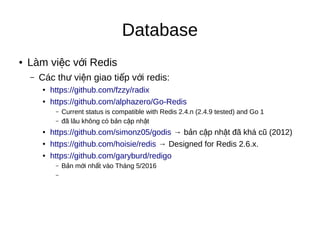
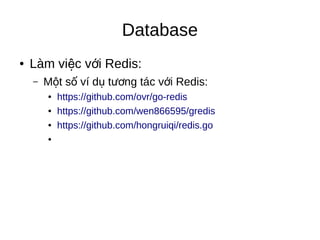
![cookies
â
Cookies g m cÃĄc tr ng:áŧ Æ°áŧ
â Name: string
â Value: string
â Path: string
â Domain: string
â Expires: time.Time
â RawExpires: string
â MaxAge: int
â Secure: bool
â HttpOnly: bool
â Raw: string
â Unparsed: []string
â
Go uses the SetCookie function in the net/http package to set cookies:
â http.SetCookie(w ResponseWriter, cookie *Cookie)
â Hà m nà y cÃģ th dÃđng cho c 2 tr ng h p t o cookies và xÃģa cookies.áŧ ášĢ Æ°áŧ áŧĢ ᚥ](https://image.slidesharecdn.com/golangwebdatabase3-160715030251/85/Golang-web-database3-13-320.jpg)
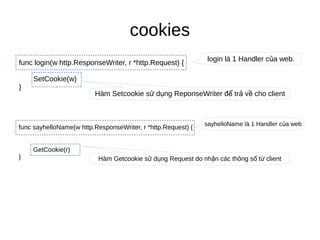
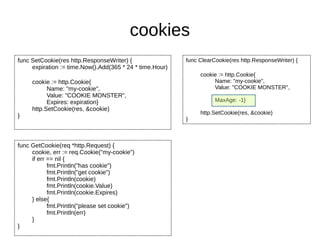
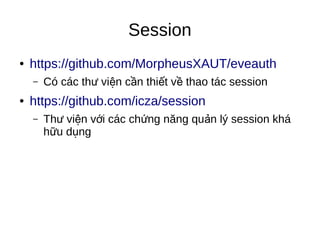
![Network service
â
we need an IP address and port number to have a unique socket.
â
TCP socket
â TCPConn struct Ä mÃī t 1 k t n i socket.áŧ ášĢ ášŋ áŧ
â TCPConn can be used by either client or server for reading and writing data.
â after a connection is established, the server has the same type of connection object for the
current connection â c phÃa client và server cÃđng cÃģ 1 object Ä mÃī t k t n i.ášĢ áŧ ášĢ ášŋ áŧ
â clients send requests to servers through a TCPConn and receive information from the server
response
â servers read and parse client requests, then return feedback
â two key functions:
â func (c *TCPConn) Write(b []byte) (n int, err os.Error)
â func (c *TCPConn) Read(b []byte) (n int, err os.Error)
â TCPAddr struct to represent TCP address information:
â ResolveTCPAddr function to get a TCPAddr](https://image.slidesharecdn.com/golangwebdatabase3-160715030251/85/Golang-web-database3-17-320.jpg)
